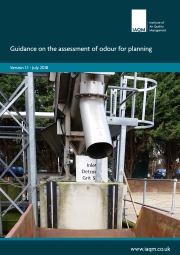Odour is an issue that air quality professionals are frequently required to assess, particularly in respect to planning. Odour impacts may be assessed when considering a planning application for an activity that may release odours or when a sensitive use is being proposed near to an existing odorous process (known as ‘encroachment’). Typical examples of potentially odorous activities are sewage works, intensive animal rearing, processing of animal remains, solid waste management (for example composting) and some industrial processes.
Some guidance on odour assessment is already available from national Government, the Scottish Environmental Protection Agency (SEPA) and the Environment Agency (EA). However, none of this specifically provides guidance applicable for planning purposes. This IAQM document has been prepared to assist practitioners involved in odour assessment for planning. It is not intended to replace existing guidance produced by the environment agencies for environmental permitting (EP) purposes or where a specific assessment method is already provided within existing guidance.
The field of odour impact assessment is a developing one. It should be noted that Inspectors' decisions on past planning appeals, though useful and often setting precedents, will have been based solely on the evidence that was presented to them, which may have been incomplete or of a different standard to current best practice: caution should therefore be exercised. This guidance describes what the IAQM considers to be current best practice; it is hoped it will assist with and inform current and future planning appeals and decisions.
Originally published: May 2014
Republished: July 2018, v1.1


